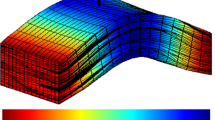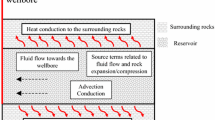Abstract
Solutions of the hydraulic diffusivity equation are of utmost importance for many reservoir engineering problems. Despite all the efforts, there is still a need for the development of rigorous and comprehensive solutions for transient flow problems in heterogeneous oil reservoirs. This study demonstrates the use of an integral transform approach to obtain such a rigorous and comprehensive solution for the hydraulic diffusivity equation in heterogeneous porous domain. The reservoir heterogeneities can be approximated by any continuous differentiable function. The presented general solution and its derivation are valid for multi-dimensional problems in any orthogonal coordinate system. It has the advantage of rigorously solving the hydraulic diffusivity equation for transient, late-transient and steady-state (or pseudo-steady-state) flow regimes in a single formulation that allows the consideration of variable flowrates. In this work, applications of the general solution for one-dimensional problems in the Cartesian and radial coordinate systems are presented, showing comparisons of the results obtained with a finite difference numerical scheme. The solution presented can be used to analyze buildup, drawdown and interference test data, making it a useful tool for pressure transient analysis applied to reservoir engineering problems.








Similar content being viewed by others
Abbreviations
- \(L_x ,L_y ,L_z ,r_e \) :
-
Reservoir dimensions
- \(N_\mathrm{i} \) :
-
Normalization integrals
- \(c_\mathrm{t} \) :
-
Total compressibility
- \(p_\mathrm{i}\) :
-
Initial pressure
- \(F\left( {{\varvec{x}}} \right) \) :
-
Initial condition
- \(a\left( {{\varvec{x}}} \right) ,b\left( {{\varvec{x}}} \right) \) :
-
Boundary condition coefficients
- k :
-
Permeability
- p :
-
Pressure
- q :
-
Flowrate
- \(x_\mathrm{p} ,r_\mathrm{p} \) :
-
Wellbore position
- \(W_\mathrm{p} \) :
-
Source term
- t :
-
Time
- \({{\varvec{x}}}\) :
-
Position vector
- S :
-
Domain surface
- V :
-
Domain region
- \(x_{c}\) :
-
Parameter of Equation (14)
- \(r_{p}\) :
-
Oil well radius
- \(\eta \) :
-
Hydraulic diffusivity coefficient
- \(\mu \) :
-
Viscosity
- \(\phi \) :
-
Porosity
- \(\phi \left( {{{\varvec{x}}},t} \right) \) :
-
Boundary condition coefficients
- \(\psi \left( {{\varvec{x}}} \right) \) :
-
Heterogeneous problem eigenfunctions
- \(\sigma \) :
-
Heterogeneous problem eigenvalues
- \(\varOmega \left( {{\varvec{x}}} \right) \) :
-
Auxiliary problem eigenfunctions
- \(\lambda \) :
-
Auxiliary problem eigenvalues
- erf:
-
Error function
- erfc:
-
Complementary error function
- \(E_\mathrm{i} \) :
-
Exponential integral function
- \(\delta \) :
-
Dirac delta function
References
Almeida, A., Cotta, R.: Integral transform methodology for convection-diffusion problems in petroleum reservoir engineering. Int. J. Heat Mass Transf. 38, 3359–3367 (1995)
Bourdet, D., Ayoub, J., Pirard, Y.: Use of pressure derivative in well test interpretation. SPE J. 4, 293–302 (1989)
Carslaw, H., Jaeger, J.: Conduction of Heat in Solids. Oxford Science Publications (1959)
Cotta, R.: Integral Transforms in Computational Heat and Fluid Flow. CRC Press, Boca Raton (1993)
Cotta, R.: Benchmark results in computational heat and fluid flow: the integral transform method. Int. J. Heat Mass Transf. 37, 381–393 (1994)
Couto, P., Moreira, R., Marsilli, M.: A General Analytical Solution for the Multidimensional Transient Linear Hydraulic Diffusivity Equation in Heterogeneous and Anisotropic Porous Media (2011)
Hovanessian, S.A.: Pressure studies in bounded reservoirs. SPE J. 1, 223–228 (1961)
Leiroz, A.J.K., Cotta, R.M.: Convergence Enhancement of Eigenfuction Expansions for Nonhomogeneous Elliptic Diffusion Problems. III Encontro Nacional de Ciências Térmicas, ENCIT 90, vol. 1, pp. 335–340, Itapema, SC, December (1990)
Matthews, C., Russell, D.: Pressure Buildup and Flow Tests in Wells. Storm Printing Corp, Dallas (1967)
Mikhailov, M., Cotta, R.: Ordering rules for double and triple eigenseries in the solution of multidimensional heat and fluid flow problems. Int. Commun. Heat Mass Transf. 23, 299–303 (1996)
Mikhailov, M., Ozisik, M.: Unified Analysis and Solutions of Heat and Mass Diffusion. Wiley, New York (1984)
Naveira-Cotta, C., Cotta, R., Orlande, H., Fudym, O.: Eigenfunction expansions for transient diffusion in heterogeneous media. Int. J. Heat Mass Transf. 52, 5029–5039 (2009)
Ozisik, M.: Heat Conduction. Wiley, New York (1993)
Rahman, N., Bentsen, R.: Use of an Integral Transform Technique for Comprehensive Solutions to Transient Flow Problems in Homogeneous Domains. PETSOC paper presented at the Canadian International Petroleum Conference, Calgary, Alberta, 4–8 June. http://dx.doi.org/10.2118/2000-042 (2000)
Rahman, N., Bentsen, R.: Comprehensive Solutions for Transient-Flow Problems in 3D Homogeneous Domains. SPE paper presented at the SPE Middle East Oil Show, Manama, Bahrain, 17–20 March. http://dx.doi.org/10.2118/68139-MS (2001)
Scofano Neto, F., Cotta, R., Mikhailov, M.: Alternative Approach to the Integral Transform Solution of Nonhomogeneous Diffusion Problems. Int. Conf. on Advanced Computational Methods in Heat Transfer, vol. 1, pp. 39–50, Southampton, UK, July (1990)
Wolfram, S.: The Mathematica Book, 5.2nd edn. Wolfram Media, Cambridge (2005)
Acknowledgments
The first author thanks Petrobras for support in the development of this work. The authors sincerely thank Prof. Carolina Naveira-Cotta for sharing her knowledge and expertise with integral transforms during the development of this work. The second and third authors also acknowledge CNP\({_\mathrm{q}}\) and FAPERJ for the continuous support of their research projects during the past years.
Author information
Authors and Affiliations
Corresponding author
Appendices
Appendix 1
The eigenvalues, eigenfunctions and norms of the auxiliary eigenvalue problem used to solve the problem given by Eqs. (13a) through (13d) are:
Appendix 2
The eigenvalues, eigenfunctions and norms of the auxiliary eigenvalue problem used to solve the problem given by Eqs. 16a–16d are:
Appendix 3: Integral Balance
The integral balance can be used as a tool to accelerate the convergence of the eigenfunction expansions, as presented by Scofano Neto et al. (1990) and Leiroz and Cotta (1990). This technique is used in order to attain a faster convergence of the spatial derivatives of pressure. The integral balance is based on the integration of the original partial differential equation (Eq. 4a) in the spatial domain followed by a manipulation of the boundary conditions. Applying the operator \(\int _0^x \mathrm{d}x\) in Eq. 4a:
substituting a boundary condition with known value of \(\partial p(x, t)/\partial x\) in Eq. 24, one can obtain an expression for \(\partial p(x, t)/\partial x\) with excellent convergence behavior.
Figure 9 presents \(\partial p(x, t)/\partial x\) for the problem presented in Case 2 as calculated by two ways: (a) deriving the solution given by Eq. 6 and using 300 terms in the eigenfunction expansion and (b) by applying the integral balance with 100 terms in the eigenfunction expansion.
Pressure derivative throughout the reservoir calculated by: a deriving Eq. 6 and b integral balance
The convergence behavior of \(\partial p/\partial x\) as calculated by deriving Eq. 6 and by using the integral balance is presented in Tables 8 and 9, respectively.
As can be seen in the analysis of Fig. 9 and Tables 8 and 9, the integral balance greatly enhances the convergence behavior of \(\partial p/\partial x\) and can be used to attain converged solutions of the flow velocities during transient flow in heterogeneous porous media.
Rights and permissions
About this article
Cite this article
Deucher, R.H., Couto, P. & Bodstein, G.C.R. Comprehensive Solution for Transient Flow in Heterogeneous Porous Media. Transp Porous Med 113, 549–566 (2016). https://doi.org/10.1007/s11242-016-0710-2
Received:
Accepted:
Published:
Issue Date:
DOI: https://doi.org/10.1007/s11242-016-0710-2





